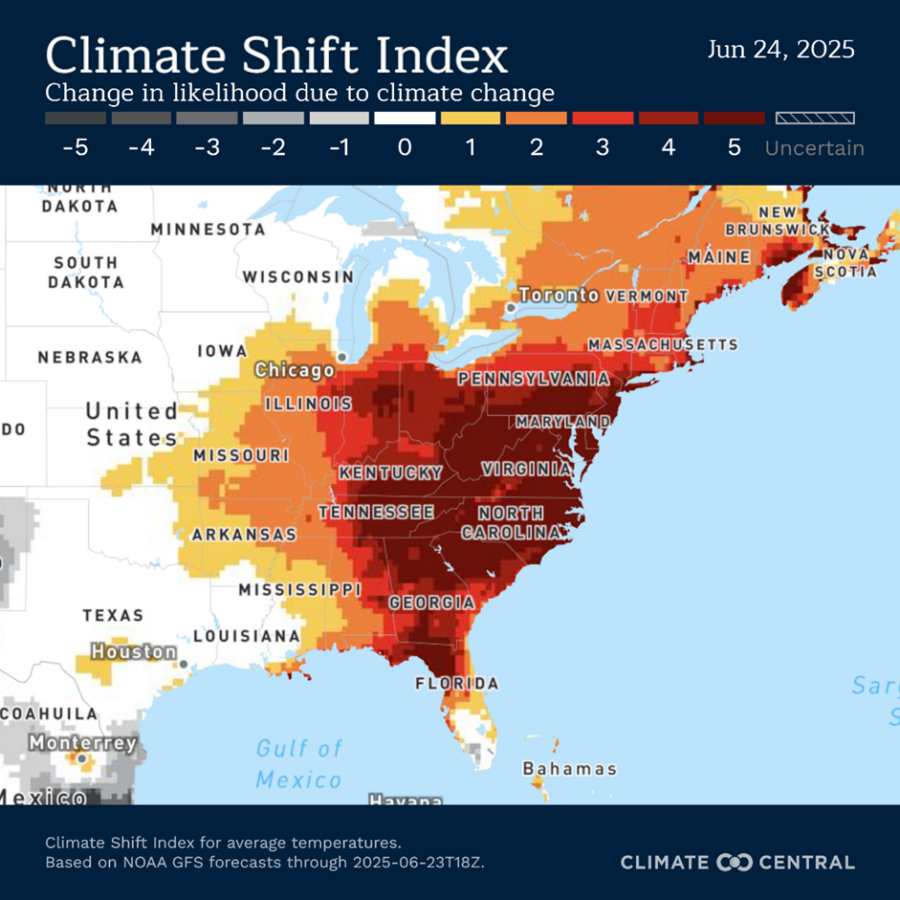Amanda Fencl, Mike Jacobs, and Carlos Martinez contributed to this report.
This post is the second installment of our Danger Season Weekly Outlook and roundup—and a dangerous week it’s been.
While we saw the first named storm of the North Atlantic hurricane season, and while wildfires expanded in several states, extreme heat has dominated daily life for much of the nation, with a persistent heat dome encompassing most of the eastern half of the US since this past weekend and subjecting the majority of the population to dangerously hot conditions.
What we’re tracking weather-wise: historic, harmful heat dome that hasn’t let up
- By the numbers: Records toppled for June, some annual high records set; stunning humidity and Heat Index values. The historic heat dome has broken 322 daily high temperature records across the Midwest, Northeast, and Mid-Atlantic since Sunday. Boston, Newark, New York City JFK Airport, Providence, Rhode Island, Manchester, New Hampshire, and Portland, Maine either tied or broke their highest temperature recorded for the entire month of June. The record heat continued overnight, as many communities experienced record-breaking warm lows. New York City’s Central Park and Minneapolis-St. Paul had their earliest-ever low of 80F since records began in 1869 and 1872, respectively. A record warm low, or record high minimum temperature, is the highest minimum temperature recorded on a given date at a given weather station. These records get broken when nights are very hot.
- “Extreme” risk: Areas of “extreme” heat risk, according to the NWS heat risk product, which are typically rare, have been widespread over the Midwest, mid-Atlantic, and Northeast this week. Parts of Ohio will have seen nearly a week under “extreme” conditions. This heat wave has been especially dangerous because of:
- the severity of the humidity, which makes it harder for our bodies to sweat efficiently and cool ourselves;
- the number of successive days of extreme conditions, which makes it harder for our bodies to shed accumulating heat;
- the elevated nighttime temperatures, meaning little overnight relief and recovery for overheated bodies;
- its unusual early onset in the summer season, when people are less physically acclimated to heat;
- and its coverage of more northern states where people, homes, workplaces and infrastructure are generally less prepared for such intense heat.

- Health impacts: Visible examples of heat illness made the news when a Major League Baseball pitcher, shortstop, and umpire each fell ill from heat in three separate Midwest baseball games. But less visible will be people’s pre-existing health conditions that are exacerbated by heat stress this week. So far, two deaths, one in Dallas, one in St. Louis, Missouri, are being attributed to this heat wave. We are learning that the deceased woman in St. Louis, who succumbed after several hot days in her un-airconditioned home, had her power shut off by the local electric utility on June 11.
- Grid strain and dirty-fuel use: Overheating of electric grid equipment caused isolated power outages around the US. Demand for electricity hit new highs in the Northeast. Supplies were tight, leading grid operators to use the dirtiest power plants to meet the elevated demand. Oil burning plants, both expensive and dirty, were used in regions that have hundreds of new solar and wind generators waiting for approvals to build. Coal was used in New England, a rarity, to meet 1% of the demand on Tuesday. These most-expensive plants pushed real-time prices for electricity incredibly high, which will ultimately impact the pocketbooks of consumers.

Climate signal: Extreme heat is one of the most direct ways we experience climate change: it is well documented that heatwaves are becoming more frequent and lasting longer in the US. During heat events, we turn to the Climate Shift Index, a tool developed by our friends at Climate Central, that quantifies the role of climate change in the near-term heat forecast. This week’s most intense heat, it shows, was made 3, 4 and 5 times more likely because of climate change.

Some of the implications we’re concerned about
- Heat can kill: Heat can sicken and kill vulnerable people, and at high enough combinations of temperature and humidity, heat can sicken and kill anyone. It is the leading cause of weather-related death in the US and globally, despite significant undercounting. Spikes in mortality during heatwaves have been well-documented in Europe and a study released last week projected 570 “excess deaths” in England and Wales from their June 19-22 heatwave. While air conditioning is far more prevalent in the US, not everyone has reliable access to it, and as noted above, outages this week left tens of thousands of households unable to run theirs.
- Heat protections are patchy across states, needed at the federal level: Workers face great risks during extreme heat, especially those who must labor outdoors. But only seven states have protections in place, like required water breaks and access to shade. As we noted in last week’s Outlook, the first-ever proposal for an OSHA federal standard for worker heat protections is going through a virtual public hearing process, now through July 2, 2025 (here’s the full schedule). But whether the Trump administration will finalize a strong rule is a big question.
- Indoor spaces are safe if they are sufficiently cooled, but households with fewer resources may not have air conditioning or may not be able to afford to run it. For people unable to pay their electricity bills, the question of whether their electricity provider can shut off their power amid extreme heat can become a life and death one, as we see with the tragedy in St. Louis. Across states, there is a patchwork of regulations preventing utilities from doing so, but a federal moratorium is needed. Low-income households may also need assistance keeping up with electricity bills, assistance provided to states by the Low-Income Housing Energy Assistance Program (LIHEAP) for distribution. But not all states make LIHEAP funds available to households for summer cooling costs.
- The kind of help people in the US get during extreme heat depends on where you live. Whether outdoor workers have protections, whether lower income people can access funds to help pay for air conditioning: there’s a patchwork of state rules and standards. That’s not good enough in our climate-changed present and not nearly good enough for where we’re headed. What we need is a strong, proactive, integrated, national approach to making us safer during the heat waves that global warming has already exacerbated and will steeply worsen in the years ahead.
- Despite this need, Trump administration and Congress are cutting heat protection resources across the federal government: The federal government supports heat safety and resilience in a range of ways, many of which are facing staff and budget cuts. We’ll be tracking and digging into these in the weeks ahead. But as the Federation of American Scientists noted in its recent report, “In April, the entire staff of the Climate and Health program at CDC, the Low Income Home Energy Assistance Program (LIHEAP), and all of the staff at the National Institute for Occupational Safety and Health (NIOSH) working on extreme heat, received reduction in force notices. […] While it appears that staff are returning to the CDC’s National Center for Environmental Health, they have lost months of time that could have been spent on preparedness, tool development, and technical assistance to local and state public health departments.”
- In addition, the Trump Administration’s proposed FY26 budget , if passed (which Congress should refuse), would eliminate the LIHEAP funding completely (see budget request p. 9), LIHEAP serves around 6 million low-income households. These already income-strained families could face extreme heat vulnerabilities with the removal of LIHEAP assistance, particularly for the elderly and those with limited mobility. Though 2025 LIHEAP funds have been distributed, the future of LIHEAP is in question.
What you can do now
What the Congressional majority and the Trump administration are pushing during federal budgeting processes will make the federal policy response much worse. It will slash protections for vulnerable people (with heat protections just the tip of the iceberg), slash the federal science infrastructure that helps keep us safe, and slash the deployment of clean energy and clean vehicles, key solutions to tackling climate change.
The heat is forecast to ease going into the weekend, so let’s all cool down and let off some steam by calling on our members of Congress to block the disastrous federal budget process underway right now.

